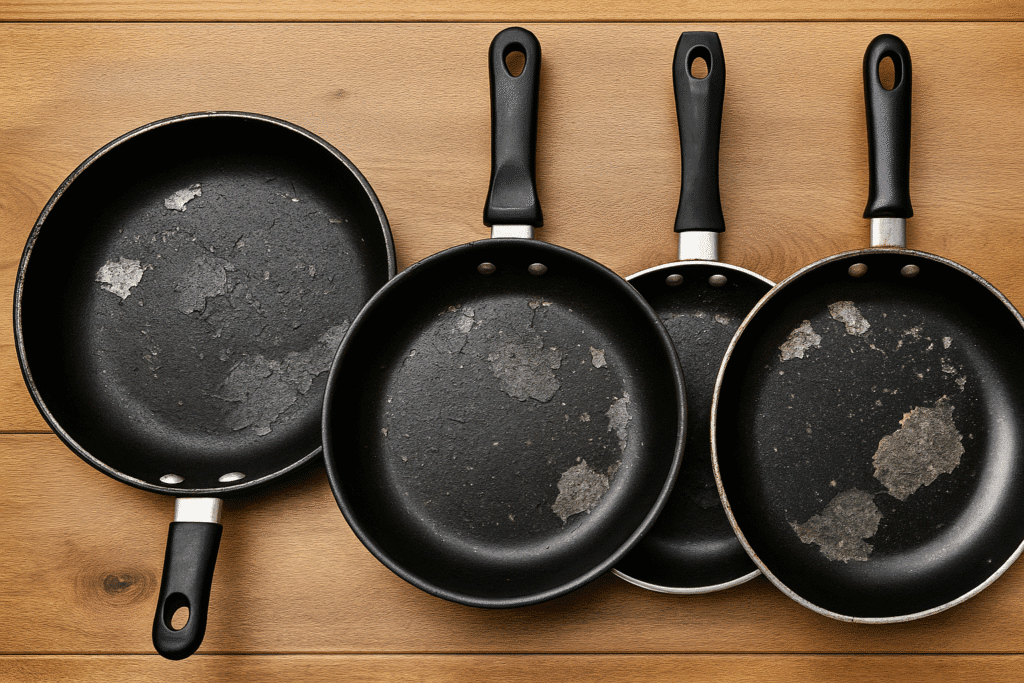The Problem With Nonstick Pans
Nonstick pans are everywhere because they’re easy. Toss some eggs in, slide them out, wipe, done. But here’s the truth nobody likes to talk about: nonstick is built on chemicals your body doesn’t want.
Most are coated with PTFE (aka Teflon) or a cousin in the same family of “forever chemicals.” Heat them past 450°F and the coating breaks down — releasing toxic fumes into your kitchen. Scratched pans? That coating ends up in your food as micro-particles.
And don’t fall for “PFOA-free” labels. Companies just swap one sketchy chemical for another (like GenX), and the science already shows those carry the same risks.
This post contains affiliate links, which means I may earn a small commission if you buy through them, at no extra cost to you. I only share products I genuinely use and believe in. Thanks for supporting the blog and helping me keep this content free.

Why You Should Care
- Forever chemicals: They don’t break down in your body or the environment.
- Toxic fumes: Overheated pans can literally make you sick.
- Scratched = flakes in your food: Not seasoning, not flavor, just plastic in your gut.
- Disposable junk: Nonstick lasts a year or two. Real pans last a lifetime.
Nonstick pans are the definition of modern convenience at a cost — cheap now, expensive later.
Real Cookware That Won’t Screw You Over
Cast Iron
Heavy. Old-school. Bombproof. Season it right and it’s naturally nonstick — no chemicals required.
- Why it works: Adds a little iron, holds serious heat, lasts generations.
- Best for: Steaks, roasts, anything that needs a crust.
My favorite cast iron pan: Lodge Cast Iron
Carbon Steel
Think cast iron, but faster and easier to handle. Still primal, just lighter.
- Why it works: Slicks up fast when seasoned with real fat. Handles high heat like a champ.
- Best for: Eggs, stir-fries, daily use.
The carbon steel pan I recommend: Lodge Carbon Skillet
Stainless Steel
The pro kitchen standard. Clean, tough, zero chemicals.
- Why it works: 100% non-toxic, scrubs clean, works with acidic foods.
- Best for: Sauces, proteins, everyday cooking.
Grab a stainless steel pan here. Made in Cookware Stainless Steel Pan
How to Season the Right Way (No Seed Oils)
Forget “vegetable oil” or flaxseed gimmicks. They leave behind weak, unstable coatings. If you want a pan that lasts, use real fats:
- Beef Tallow — glossy, durable, made for heat.
- Ghee (clarified butter) — stable, smooth, long-lasting.
- Lard — old-school, proven for generations.
How to do it: coat lightly, bake hot, repeat. And every time you cook in these fats, you reinforce the natural nonstick surface. Simple.
FAQ
Are ceramic pans safe?
Safer than Teflon, but still chip and wear out fast. Better, but not forever.
Is stainless steel really non-toxic?
Yep. High-quality stainless doesn’t leach chemicals, even at high heat.
Are “PFOA-free” pans safe?
Nope. PFOA is gone, but companies just swapped in other PFAS chemicals. Different name, same story.
Which cookware lasts the longest?
Cast iron and stainless steel can outlast you. Carbon steel too if you take care of it. Nonstick is landfill in 1–2 years.
Nonstick pans are modern junk food for your kitchen — fast, cheap, and convenient, but loaded with hidden costs. If you care about what’s in your body, it starts with what you cook on.
Ditch the disposable pans. Go cast iron, carbon steel, or stainless steel. They don’t leach toxins, they make your food taste better, and they’ll be around long after your nonstick’s in the trash.
Sources
- Begley, T. H., et al. (2005). Perfluorochemicals: Potential sources of and migration from food packaging. Food Additives and Contaminants, 22(10), 1023–1031.
- Sinclair, E., & Kannan, K. (2006). Mass loading and fate of perfluoroalkyl surfactants in wastewater treatment plants. Environmental Science & Technology, 40(5), 1408–1414.
- Agency for Toxic Substances and Disease Registry (ATSDR). (2021). Toxicological Profile for Perfluoroalkyls (PFAS). U.S. Department of Health and Human Services.
- Grandjean, P., & Clapp, R. (2015). Perfluorinated alkyl substances: Emerging insights into health risks. New Solutions, 25(2), 147–163.
- U.S. Environmental Protection Agency (EPA). (2022). Our Current Understanding of the Human Health and Environmental Risks of PFAS.
- Cleveland Clinic. (2023). Are Nonstick Pans Safe? health.clevelandclinic.org/are-nonstick-pans-safe
- Lau, C., et al. (2007). Perfluoroalkyl acids: A review of monitoring and toxicological findings. Toxicological Sciences, 99(2), 366–394.

Leave a Reply